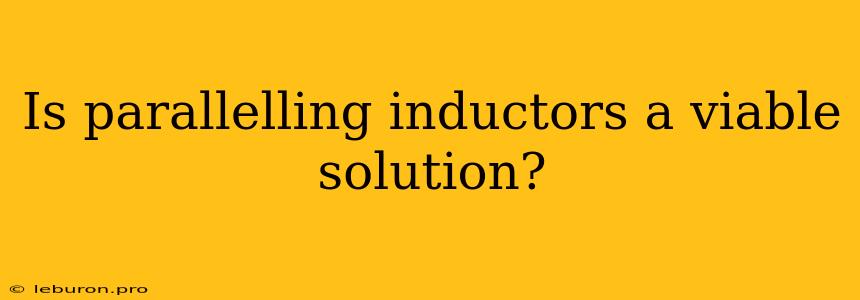Paralleling inductors is a common technique used in electronic circuits to achieve a desired inductance value or to increase current handling capability. However, it is important to understand the limitations and potential drawbacks of paralleling inductors before implementing this technique. This article will explore the viability of paralleling inductors and provide insights into its advantages, disadvantages, and considerations.
Understanding the Basics of Paralleling Inductors
Inductors are passive electronic components that store energy in a magnetic field when current flows through them. The inductance of an inductor is measured in Henrys (H) and represents its ability to resist changes in current. When inductors are connected in parallel, their inductances combine in a way that is analogous to resistors connected in series.
The total inductance (L_total) of parallel inductors is calculated using the following formula:
1/L_total = 1/L1 + 1/L2 + 1/L3 + ... + 1/Ln
Where:
- L_total: Total inductance of the parallel combination.
- L1, L2, L3, ... Ln: Inductances of individual inductors.
Advantages of Paralleling Inductors
There are several advantages to paralleling inductors:
- Increased Current Handling Capacity: Connecting inductors in parallel effectively increases the overall current rating of the circuit. This is because the current is distributed among the parallel inductors, reducing the stress on each individual inductor.
- Achieving Specific Inductance Values: By carefully selecting the inductance values of the individual inductors, it becomes possible to achieve a desired total inductance that may not be readily available as a single component.
- Improving Circuit Stability: Paralleling inductors can reduce the impact of variations in inductance between individual components. By distributing the current, the overall inductance becomes less susceptible to fluctuations due to manufacturing tolerances or temperature changes.
Disadvantages and Considerations
While paralleling inductors can offer benefits, it also comes with several disadvantages and considerations that need to be addressed:
- Mutual Inductance: When inductors are placed close together, their magnetic fields can interact with each other, leading to mutual inductance. Mutual inductance can alter the effective inductance of the parallel combination and introduce unwanted coupling effects, potentially affecting circuit performance.
- Parasitic Capacitance: Inductors inherently possess parasitic capacitance due to the winding structure. When paralleled, these parasitic capacitances can add up, potentially forming resonant circuits at certain frequencies. This resonance can lead to unpredictable circuit behavior and instability.
- Current Distribution: Ideally, the current should be evenly distributed among the paralleled inductors. However, this might not always be the case due to variations in inductance, winding resistance, or parasitic elements. Uneven current distribution can cause excessive heat generation and potential failure in one or more inductors.
- Cost and Complexity: Paralleling inductors can increase the cost of a circuit due to the need for multiple components and the complexity involved in ensuring proper placement and isolation.
- Space Constraints: Depending on the size and configuration of the inductors, paralleling them may require additional space on the circuit board, especially in applications where space is limited.
Factors Affecting the Viability of Paralleling Inductors
The viability of paralleling inductors depends on various factors, including:
- Frequency of Operation: At high frequencies, the effects of parasitic capacitance and mutual inductance become more significant. This can make paralleling inductors less viable at higher frequencies.
- Application Requirements: The specific requirements of the circuit will dictate whether paralleling inductors is a suitable solution. For example, if high current handling capacity is a priority, paralleling inductors might be a viable option. However, if precise inductance value and stability are critical, other approaches might be more appropriate.
- Component Availability: The availability of inductors with the desired characteristics and ratings will also influence the decision to parallel them.
- Cost and Complexity: The trade-off between the cost of multiple components and the complexity involved in paralleling inductors needs to be carefully considered.
Alternatives to Paralleling Inductors
If paralleling inductors is not a viable solution, there are alternative methods for achieving the desired inductance value or increasing current handling capacity:
- Using a Single Inductor with a Higher Rating: This is the simplest solution but might not be feasible if a suitable inductor with the required rating is not readily available.
- Using a Toroidal Inductor: Toroidal inductors have a closed magnetic core, which minimizes the effects of mutual inductance.
- Using a Multilayer Inductor: Multilayer inductors have multiple layers of windings, allowing for higher inductance values and better current handling capability compared to single-layer inductors.
Conclusion
Paralleling inductors can be a viable solution for increasing current handling capacity and achieving specific inductance values in electronic circuits. However, it is important to carefully consider the potential disadvantages and limitations associated with this technique. Factors such as frequency of operation, application requirements, component availability, and cost and complexity must be evaluated before implementing paralleled inductors. If paralleling inductors is not feasible, alternative methods such as using a single inductor with a higher rating, toroidal inductors, or multilayer inductors can be explored to achieve the desired circuit functionality. In many cases, a thorough analysis of the specific application requirements and a careful consideration of the trade-offs involved will lead to the most appropriate and effective solution.
